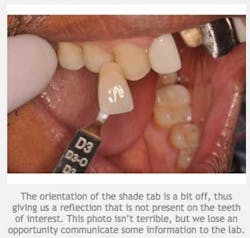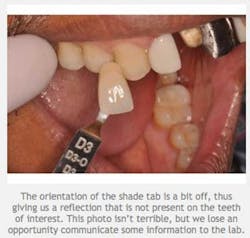Communicating shade to dental labs
Reprinted with permission from The Curious Dentist, Dr. Chris Salierno's clinical and practice management website.
I used to just write “A2″ in a box on a lab sheet and hope that the lab would figure it out. That was pretty dumb. Unfortunately (or fortunately), our teeth are not identical to the VITA shade guide tabs. There is far more complexity that exists in our dentin and enamel, so if we hope to acheive a higher level of replication, we must put in more effort than just writing a letter and a number on a lab script.
The good news is that you don’t need a masters degree in fine arts to be able to take a good shade. Here are some simple steps that I've used successfully:
(1) Buy a damn digital SLR camera with flash and macro lens
I promise you that getting a professional camera will bring you to another level of dentistry. There are a number of reasons, which our friend, Dr. Albert Yoo, wrote about in a recent issue of Dental Economics. But for now, let’s be concerned with the fact that shade communication is far better with a proper camera setup than with your smartphone. Two popular places to get the whole package are Lester Dine and PhotoMed.
(2) Pick a few shades that look good
Don’t just pick one shade for your photo, pick a few. Chances are that there’s more than one shade tab that will offer insight into the teeth of interest. Giving more than one tab will also give the lab technicians some variety and the ability to compare elements of color between photographs. Don’t forget to give the lab a stump shade (shade of the prepared tooth) if you're using all-ceramic restorations.
(3) Take a proper photograph with the shade tab
Make sure the tab identifier is visable (e.g., A2, C4, etc). Make sure the tab is held at a similar orientation as the teeth of interest so that the light plays off of it in a similar way. Take a few photographs under different lights and not just in your treatment room.
(4) There’s more than just shade to communicate
Of course we’re not only interested in communicating shade, are we? There is also characterization and texture. What are the nuances of how the shade is distributed on the surfaces, and what tiny lumps and bumps are to be found? For these bits I like to take an extreme close-up photo, which can only be done with a camera with a proper macro lens. This can be separate from your shade tab photos so you’ll have a free hand to use a cool toy like a contrastor.
Chris Salierno, DDS, is the editor of Dental Economics. He is a nationally-recognized author and lecturer. His audiences include dentists, dental students, office managers, and hygienists. His areas of expertise include practice management, leadership development, implant prostheses, occlusion, and cosmetic dentistry.




